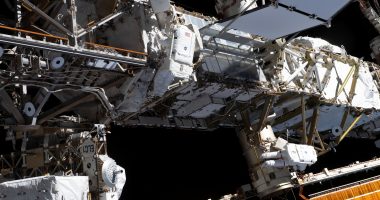NASA’s Hubble Space Telescope has captured many stunning images over its lifetime – here are five of the most mind-blowing.
First conceived in the 1940s, the Hubble Space Telescope (or just Hubble for short) was launched by the US space agency on April 24, 1990.
Named after astronomer Edwin Powell Hubble (1889–1953), the instrument currently hovers about 340 miles (547 km) above Earth’s surface and completes 15 orbits a day.
It is one of Nasa’s four great observatories, along with the Compton Gamma Ray Observatory, the Chandra X-ray Observatory, and the Spitzer Space Telescope.
Numerous scientific observations that have furthered man’s understanding of the universe are can be credited to Hubble.
And while the telescope’s list of achievements is long, some of its most notable feats include helping astronomers determine the age of the universe and observing the rate at which it is expanding.
Nasa has called the instrument one of humanity’s greatest scientific inventions.
Since its launch, the device has made more than one million observations.
Many of which include detailed pictures of the birth and death of stars, and galaxies billions of light-years away.
Below we share some of the most mind-blowing images the device has captured in the past decade.
1. The Butterfly nebula (2020)
Perhaps one of the most stunning images of NGC 6302, or the “Butterfly Nebula,” this photograph was released by Nasa on June 18, 2020.
It depicts the Butterfly Nebula across a complete spectrum of light, from near-ultraviolet to near-infrared to help “researchers better understand the mechanics at work in its technicolor ‘wings’ of gas,” Nasa said.
The star(s) at its center is responsible for the nebula’s wing, which are regions of heated gas of more than 36,000 degrees Fahrenheit.
NGC 6302 is located between 2,500 and 3,800 light-years away in the constellation Scorpius.
2. The Saturn Opposition (2018)
One of the most iconic photos of Saturn was captured by Hubble.
The image was released by Nasa on July 26, 2018, and provides a detailed visual of Saturn’s magnificent ring system.
Saturn was only approximately 1.36 billion miles from Earth when this image was taken – that’s about as close as it ever gets to us.
3. The Veil Nebula (2015)
Released on September 24, 2015, this image shows a section of the expanding remnants of a supernova explosion from 8,000 years ago, Nasa said.
Dubbed the Veil Nebula, the space debris resides about 2,100 light-years away in the constellation Cygnus, the Swan.
The whole nebula spans a massive 110 light-years across.
4. The Pillars of Creation (2015)
This image of part of the Eagle Nebula was released by Nasa on January 05, 2015.
Hubble scientists took the photograph in near-infrared light to reveal incredible stellar details behind the nebula, made of gas and dust clouds.
New stars can also be seen at the tops of the pillars, which are unseen in visible light images.
5. The Herbig-Haro Jet HH24 (2015)
Nasa described this image as “a cosmic, double-bladed lightsaber.”
In the center of the image, a newborn star, which is partially blocked by dust, shoots out luminescent twin jets.
The photograph was released on December 17, 2015, just ahead of the release of the movie Star Wars Episode VII: The Force Awakens.


“Science fiction has been an inspiration to generations of scientists and engineers, and the film series Star Wars is no exception,” said John Grunsfeld, astronaut and associate administrator for NASA’s Science Mission Directorate.
“There is no stronger case for the motivational power of real science than the discoveries that come from the Hubble Space Telescope as it unravels the mysteries of the universe.”
We pay for your stories!
Do you have a story for The US Sun team?
















